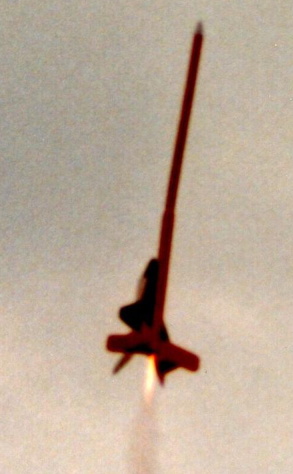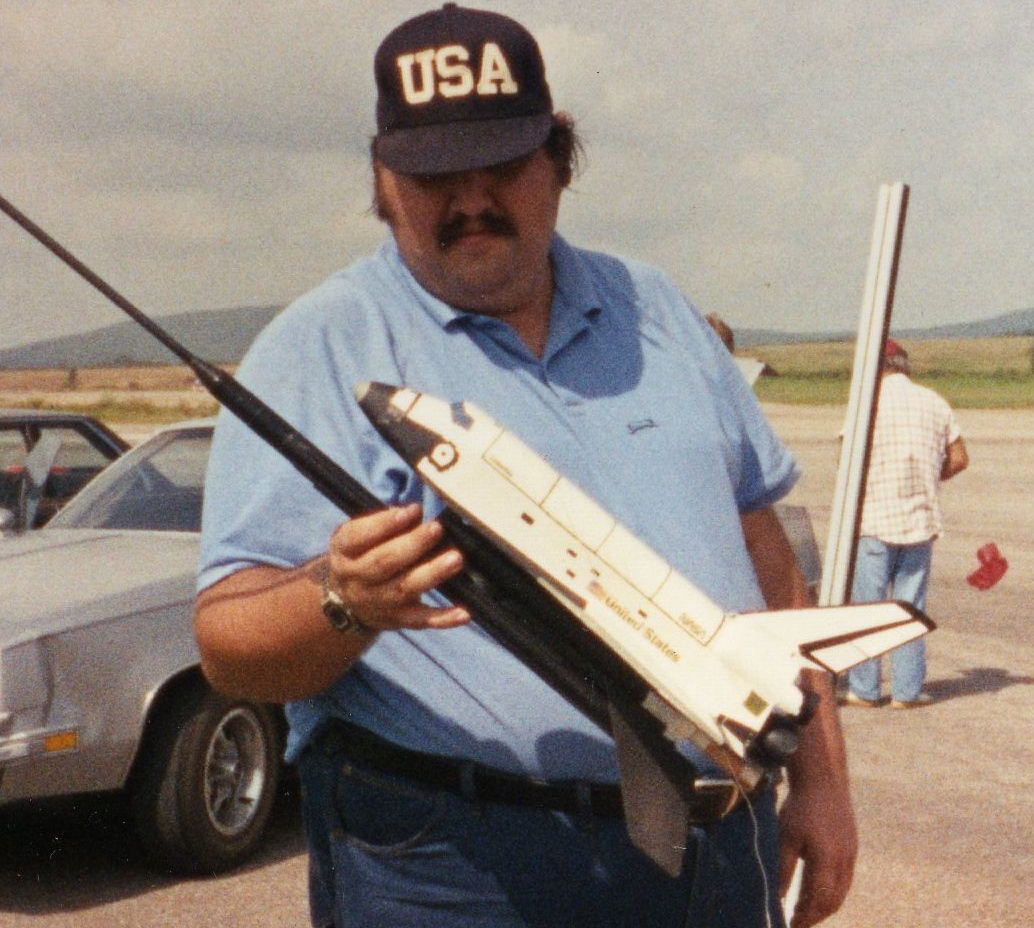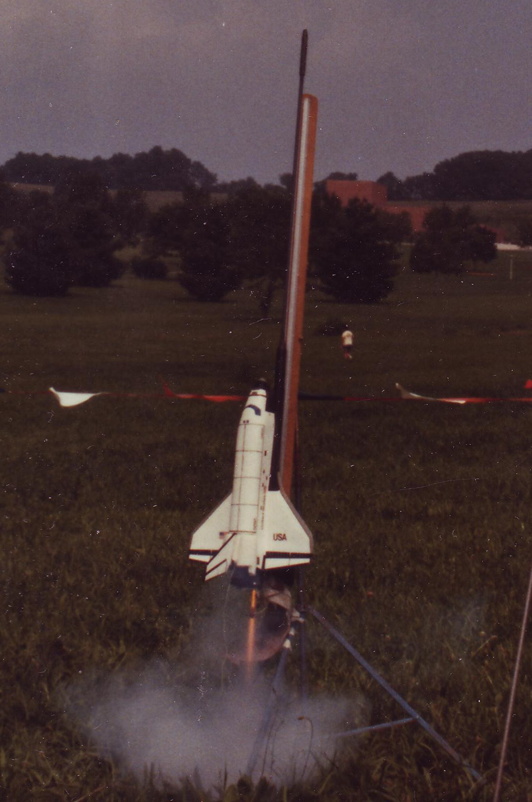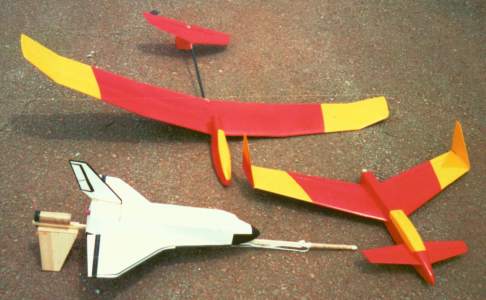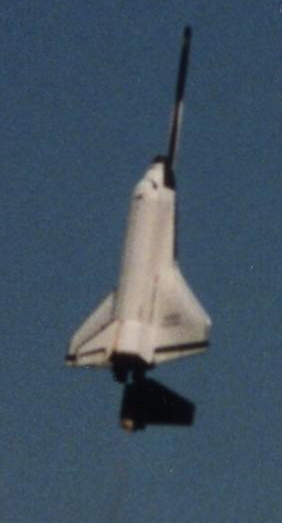- Joined
- Jul 29, 2014
- Messages
- 2,114
- Reaction score
- 715
At the DARS launch in October, I finally got around to flying my R/C Guillow's Space Shuttle conversion as a parasite on a rocket.
By the way, did anyone at the launch happen to get a picture?...
A number of years back, I converted one of these to electric pusher with great success. Back in 2004, I used two HS-50 servos, a micro GWS RX, a two cell 240 lipo, 5 amp ESC and the 12mm direct drive GWS brushed motor. Pictures attached.
I cheated on the elevons by adding all of the elevon to the existing model's trailing edge. This adds a small amount of badly needed wing area.
I recently removed the electric motor and redid the model to fly as a parasite on a D12 powered rocket. I happened to have a old Estes Mean Machine that took a major tube crumple during a household move years back. I took the damaged airframe, cut it down to where the crumple was (a little less than half the length) and added a parasite glider mount for the foam Shuttle.
I changed out everything in the glider except for the HS-50 servos. Added a Spektrum AR400 RX, a 2 cell 180 lipo and used a sub micro 5 amp ESC to provide BEC power to the radio. The equipment was arranged to put the CG where it needed to be with no ballast added.
I did a few hand glides to get the control rates and trim close before launch. I set up the model with a good bit of expo in the aileron channel to keep the small model from being overly reactive and twitchy around neutral.
The first flight on a D12-3 was great. Decent altitude with some slight steering of the shuttle and rocket in roll and pitch during boost and coast. Clean separation and a nice glide back to the launch area. The programmed expo in roll made the little model pleasant to fly.
Second flight was a prang partly due to a switchology error on my part..... . I forgot to set the preprogrammed mixing switch on the elevons to set them to zero for the boost. Between the model tipping off the rod a little, the offset rocket CG due to the weight of the Shuttle on the side of the model and the up elevator trim for the booster glide, the model went instantly horizontal and hit the ground before motor ejection.
. I forgot to set the preprogrammed mixing switch on the elevons to set them to zero for the boost. Between the model tipping off the rod a little, the offset rocket CG due to the weight of the Shuttle on the side of the model and the up elevator trim for the booster glide, the model went instantly horizontal and hit the ground before motor ejection.
The tube on the booster crumpled and the foam shuttle took some damage, but is repaired and spackled back to good condition.
Currently rebuilding the single Shuttle booster with an offset motor mount attached to the booster tube's inside surface directly under the shuttle to correct the thrust line to better match the offset CG of the booster and shuttle combo.
Have also started another booster with mounts for two of the shuttles, one on each side, for 24mm E and F power.
Two or three more of the Guillow's Shuttles are being modified for RC. One with micro RC using discrete components and one or two with the tiny and very light Spektrum AR6410 brick.
Will post some pictures of the mods and boosters over time as things progress.


By the way, did anyone at the launch happen to get a picture?...
A number of years back, I converted one of these to electric pusher with great success. Back in 2004, I used two HS-50 servos, a micro GWS RX, a two cell 240 lipo, 5 amp ESC and the 12mm direct drive GWS brushed motor. Pictures attached.
I cheated on the elevons by adding all of the elevon to the existing model's trailing edge. This adds a small amount of badly needed wing area.
I recently removed the electric motor and redid the model to fly as a parasite on a D12 powered rocket. I happened to have a old Estes Mean Machine that took a major tube crumple during a household move years back. I took the damaged airframe, cut it down to where the crumple was (a little less than half the length) and added a parasite glider mount for the foam Shuttle.
I changed out everything in the glider except for the HS-50 servos. Added a Spektrum AR400 RX, a 2 cell 180 lipo and used a sub micro 5 amp ESC to provide BEC power to the radio. The equipment was arranged to put the CG where it needed to be with no ballast added.
I did a few hand glides to get the control rates and trim close before launch. I set up the model with a good bit of expo in the aileron channel to keep the small model from being overly reactive and twitchy around neutral.
The first flight on a D12-3 was great. Decent altitude with some slight steering of the shuttle and rocket in roll and pitch during boost and coast. Clean separation and a nice glide back to the launch area. The programmed expo in roll made the little model pleasant to fly.
Second flight was a prang partly due to a switchology error on my part.....
The tube on the booster crumpled and the foam shuttle took some damage, but is repaired and spackled back to good condition.
Currently rebuilding the single Shuttle booster with an offset motor mount attached to the booster tube's inside surface directly under the shuttle to correct the thrust line to better match the offset CG of the booster and shuttle combo.
Have also started another booster with mounts for two of the shuttles, one on each side, for 24mm E and F power.
Two or three more of the Guillow's Shuttles are being modified for RC. One with micro RC using discrete components and one or two with the tiny and very light Spektrum AR6410 brick.
Will post some pictures of the mods and boosters over time as things progress.


Last edited:







